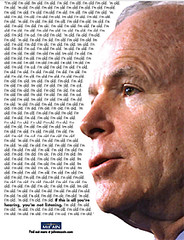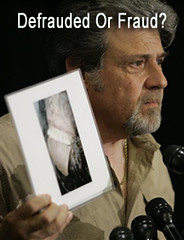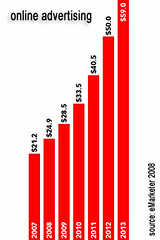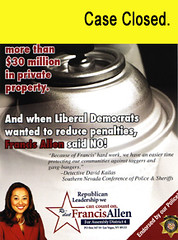Adweek recently challenged several creative directors to sell the next president of the United States. According to the special report, several declined and some took to tongue-in-cheek humor.
After the fine folks at The Rosen Group brought the special report to our attention, my team thought it might be fun to review some of these faux campaign concepts (here). After all, I’ve often felt that not all advertising agencies are cut out for political campaigns — the work sometimes leans too creative to really resonate with voters. Am I right? Let’s find out.
Mike Byrne, Anomaly: Disqualified
It’s not that we don’t like Byrne’s industry twist on the assignment that pits McCann Erickson against Obamaly (as opposed to McCain vs. Obama). We like the "agency as opposed to politics" spoof as well as well as the obvious old vs. new parallels that drives it. Unfortunately, it veers too far off from being applicable for this post.
John Butler, Butler, Shine, Stern & Partners: Below Average
Butler’s first contribution borrows the well-known 1984 re-elect Ronald Ragan spot and points out that Obama doesn’t have to run against John McCain. I’ve always had mixed feelings about the "choose a different opponent" approach. Why? “Running against others” has a relatively low success rate. Much funnier (though neither would make it) are his billboard contributions: the McCain billboard that declares “God is my running mate” while Obama’s reads “It’s Obama Time.”
Peter Nicholson, Deutsch: Not Good
Nicholson tosses in a refreshed “I Want You” poster with McCain playing the part of Uncle Sam. The supporting copy reads: … to feel sorry for my POW ass. While the Obama campaign team would have to pass, it might fly as an independent expenditure. Nicholson seems to have caught that McCain’s POW experience isn’t resonating with voters this cycle as it did when he ran against George W. Bush.
Jamie Barrett, Goodby, Silverstein & Partners: Average
Barrett doesn’t pick sides, except the one against political advertising. He positions McCain as the 174-year-old candidate and Obama an as the “?” candidate. He makes the right point, but without the payoff. What we do like, however, is Barret’s conclusion that “maybe, just maybe, they [voters] should pay less attention to half truths they see on commercials and think a little more for themselves.”
Tom Amico, The Kaplan Thaler Group: Above Average
Amico comes to the same conclusion as Barrett. For Obama, the contribution reads “I’m black” over and over again. For McCain, it reads “I’m old” over and over again. Both posters are summed up "If this is all you're hearing, you're not listening." Sure, the conceptual behind the ad has been done more than once, but it still edges out Goodby, Silverstein & Partners because the point he’s making seems to stick with us long after the ad is over.
Nick Law, R/GA: Good
Law’s motion billboard gives people a “Make History” message for Obama and a “Repeat History” message for McCain. It’s amazingly effective at targeting the emotions of those unhappy with the administration while driving home the point that McCain might represent more of the same. Law doesn’t let Obama off the hook either. He turns Obama into a Macy’s parade blimp, reading “Overblown.” I didn’t like the Obama take at a glance, but it starts to stick after repeated viewings. We have to give it up for Law. Both ads have the potential to work.
Scott Duncan, T.A.G.: Below Average
Duncan shoots for simple with both campaign ideas. He suggests placing a straightforward “Obama” billboard in key locations, like a steel factory setting. I liked the idea at first, but pulled back from it after it started to resemble a foreshadow of things to come. Likewise, dropping the “Mc” from McCain and running with the ‘Cain seemed okay. But over time, the initial attraction wears off and you start to wonder whether the new brand name will break down.
Rob Schwartz, TBWA: Average
Schwartz has a somewhat subversive idea by asking the world to vote for president of the United States, playing off of Obama’s global momentum. Is that a good thing? He does the same with McCain, making McCain a global action figure. Is that a good thing? The sad reality is Americans would likely be as mixed on these messages as they seem to be on the candidates. I give Schwartz some props; his additional ideas are worth the read.
So there you have it. Advertising can amuse us about the political process, but the industry doesn’t always translate well for politics. Somehow, political campaigns are different. Of the creative directors brave enough to have some fun, only Law seems to come close to a deliverable. And that makes me wonder too. Was any of this fun worth any of the comments that concluded every campaign a disappointment. I don't know.
Las Vegas Agency Example
But what I do know is that we recently found a local advertising agency attempting to play politics with equally disappointing results. After going to great lengths to hide their ownership of a smear blog aimed at State Sen. Bob Beers, Drex in Las Vegas outed itself after accidently posting the blog's project files on their agency site (right alongside a client roster that includes Sen. Bob Beers supporters).
Considering the secret campaign is reported to be a $1 million attack fund against Sen. Bob Beers (so his opponent does not have to attack him), we thought it was an amazingly amateurish mistake. It was also amateurish for Drex to reinforce its first half-truth post with an anonymous comment written by the same writer who wrote the post.
I guess that gives a lot of weight to speculators who said that advertising agencies would have a hard time resisting black hat social media. Comments by anyone else are, naturally, moderated.

After the fine folks at The Rosen Group brought the special report to our attention, my team thought it might be fun to review some of these faux campaign concepts (here). After all, I’ve often felt that not all advertising agencies are cut out for political campaigns — the work sometimes leans too creative to really resonate with voters. Am I right? Let’s find out.
Mike Byrne, Anomaly: Disqualified
It’s not that we don’t like Byrne’s industry twist on the assignment that pits McCann Erickson against Obamaly (as opposed to McCain vs. Obama). We like the "agency as opposed to politics" spoof as well as well as the obvious old vs. new parallels that drives it. Unfortunately, it veers too far off from being applicable for this post.
John Butler, Butler, Shine, Stern & Partners: Below Average
Butler’s first contribution borrows the well-known 1984 re-elect Ronald Ragan spot and points out that Obama doesn’t have to run against John McCain. I’ve always had mixed feelings about the "choose a different opponent" approach. Why? “Running against others” has a relatively low success rate. Much funnier (though neither would make it) are his billboard contributions: the McCain billboard that declares “God is my running mate” while Obama’s reads “It’s Obama Time.”
Peter Nicholson, Deutsch: Not Good
Nicholson tosses in a refreshed “I Want You” poster with McCain playing the part of Uncle Sam. The supporting copy reads: … to feel sorry for my POW ass. While the Obama campaign team would have to pass, it might fly as an independent expenditure. Nicholson seems to have caught that McCain’s POW experience isn’t resonating with voters this cycle as it did when he ran against George W. Bush.
Jamie Barrett, Goodby, Silverstein & Partners: Average
Barrett doesn’t pick sides, except the one against political advertising. He positions McCain as the 174-year-old candidate and Obama an as the “?” candidate. He makes the right point, but without the payoff. What we do like, however, is Barret’s conclusion that “maybe, just maybe, they [voters] should pay less attention to half truths they see on commercials and think a little more for themselves.”
Tom Amico, The Kaplan Thaler Group: Above Average
Amico comes to the same conclusion as Barrett. For Obama, the contribution reads “I’m black” over and over again. For McCain, it reads “I’m old” over and over again. Both posters are summed up "If this is all you're hearing, you're not listening." Sure, the conceptual behind the ad has been done more than once, but it still edges out Goodby, Silverstein & Partners because the point he’s making seems to stick with us long after the ad is over.
Nick Law, R/GA: Good
Law’s motion billboard gives people a “Make History” message for Obama and a “Repeat History” message for McCain. It’s amazingly effective at targeting the emotions of those unhappy with the administration while driving home the point that McCain might represent more of the same. Law doesn’t let Obama off the hook either. He turns Obama into a Macy’s parade blimp, reading “Overblown.” I didn’t like the Obama take at a glance, but it starts to stick after repeated viewings. We have to give it up for Law. Both ads have the potential to work.
Scott Duncan, T.A.G.: Below Average
Duncan shoots for simple with both campaign ideas. He suggests placing a straightforward “Obama” billboard in key locations, like a steel factory setting. I liked the idea at first, but pulled back from it after it started to resemble a foreshadow of things to come. Likewise, dropping the “Mc” from McCain and running with the ‘Cain seemed okay. But over time, the initial attraction wears off and you start to wonder whether the new brand name will break down.
Rob Schwartz, TBWA: Average
Schwartz has a somewhat subversive idea by asking the world to vote for president of the United States, playing off of Obama’s global momentum. Is that a good thing? He does the same with McCain, making McCain a global action figure. Is that a good thing? The sad reality is Americans would likely be as mixed on these messages as they seem to be on the candidates. I give Schwartz some props; his additional ideas are worth the read.
So there you have it. Advertising can amuse us about the political process, but the industry doesn’t always translate well for politics. Somehow, political campaigns are different. Of the creative directors brave enough to have some fun, only Law seems to come close to a deliverable. And that makes me wonder too. Was any of this fun worth any of the comments that concluded every campaign a disappointment. I don't know.
Las Vegas Agency Example
But what I do know is that we recently found a local advertising agency attempting to play politics with equally disappointing results. After going to great lengths to hide their ownership of a smear blog aimed at State Sen. Bob Beers, Drex in Las Vegas outed itself after accidently posting the blog's project files on their agency site (right alongside a client roster that includes Sen. Bob Beers supporters).
Considering the secret campaign is reported to be a $1 million attack fund against Sen. Bob Beers (so his opponent does not have to attack him), we thought it was an amazingly amateurish mistake. It was also amateurish for Drex to reinforce its first half-truth post with an anonymous comment written by the same writer who wrote the post.
I guess that gives a lot of weight to speculators who said that advertising agencies would have a hard time resisting black hat social media. Comments by anyone else are, naturally, moderated.




























